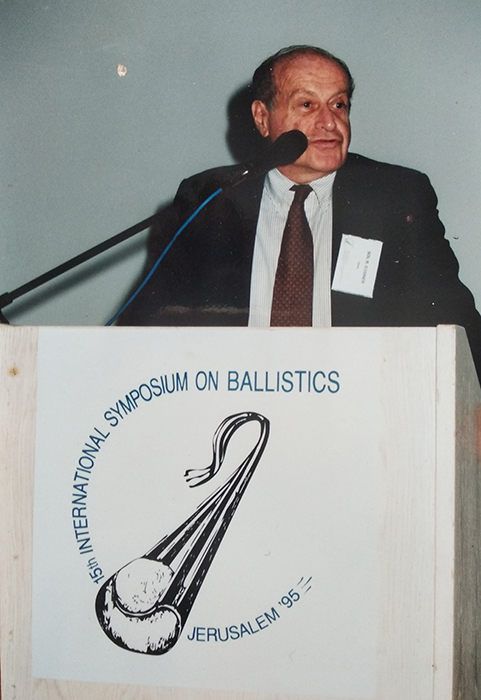Sometimes it is possible to understand something about a person from looking at his work or interests, which are interwoven in different ways throughout his life. In the case of Prof. Sol Bodner, our sights should be turned to the sea – that multilayered, large and powerful expanse, fundamental and deep, that transported him to distant realms in science and industry
In many ways, the sea was a focus of exploration, work and life for Prof. Sol Bodner. From the time he was a young lifeguard in the United States, his hobby of diving, underwater archaeology (many of his findings are displayed in the museum at Kibbutz Nachsholim) and his becoming an expert in submarines.
Sol Rubin Bodner was born in New York City on March 7, 1929 to immigrants from Austria and Poland. In 1950, he earned a bachelor’s degree in civil engineering from the Polytechnic Institute of Brooklyn, and in 1953 he received a master’s degree in mathematics from New York University’s Courant Institute. Two years later, at the age of 35, he completed his doctorate in applied mechanics at the Polytechnic Institute. These three degrees testify to the scientist who was so much more than his titles. “He was an engineer, a theorist and an experimenter,” said his colleague and friend Prof. Miles Rubin. “The combination of these three traits gave him a significant background for many of the things he did and also for his important contribution to the State of Israel.”
In 1956, Bodner became associate professor at Brown University. “At that time,” adds Prof. Rubin, “Brown University was the ‘center of the world’ of mechanics. Bodner was part of it, knew and worked with all the major researchers in the field, and eventually became one of them. This was the start of his very significant activity in the United States and Israel.”
In parallel to his work at Brown University, Bodner also began working with NASA to develop composite materials for the protection of the first spacecrafts, Mercury and Apollo. It was at Brown that Bodner’s love affair with the sea began, when he worked on the development of theories for calculating reinforced cylinders, which became the basis for the design of modern submarines. This work also led the US Navy to turn to him as an expert, which in turn jumpstarted his work on submarines in Israel.
Zionism and Love

It was during this time that Bodner forged his Zionist connection to Israel. In 1952, as a PhD student, Bodner was invited to a conference at a university in Istanbul. It was Ataturk
who, in his attempt to bring western civilization to Turkey, collaborated with American scientists, many of whom were Holocaust survivors. One of them was Professor Prager, who invited Bodner to speak at the conference. For Sol Bodner, the visit to the Middle East was an excellent opportunity to visit Israel and explore the possibility of joining the Technion. In a fairytale coincidence, Bodner stayed with relatives in Tel Aviv and met their neighbor, Nechama. “I was very impressed by his humility, his sense of humor, and also his Zionism,” says the woman who became his wife and mother of his four children. “Within two weeks we got engaged. Then I went with him to the United States, where we got married and where our children were born. We knew that eventually we would return to Israel.”
Indeed, in 1964, the promise was fulfilled: Nechama, Sol and their children immigrated to Israel. Bodner joined the Technion as a very young professor and made sure to bring funding for his research from the US Navy and Air Force, with which he worked. This was also when he began working with the Israeli Navy. “When they started building the Gal submarines and encountered problems, Israeli Navy personnel contacted the US Navy. The answer they got was: ‘Our expert is in Israel, contact him directly,'” says Nechama Bodner. And so, Prof. Bodner became involved in the design of the submarine and led theories for calculating the strength of the pressure hull. Thanks to his involvement, mistakes he discovered in the German design were avoided. He directed the design of assemblies that were tested using the Finite Element Method (FEM) – an analysis that was not yet known in Europe. He not only developed theories and made designs, but he also participated himself in the deep dives in Norway to test the stress in the submarine’s pressure body.
His extensive work in the navy also included the development, planning and repair of additional ships, and the formulation of an innovative design methodology for the pressure hull of the Dolphin submarine, which was adopted by the German designer and used in the design of all submarines thereafter.
Submarines, Tanks and Bombs
Bodner’s key topics – dynamic behavior of structures, metal viscoelastoplasty and ballistic penetration mechanics – led him to work with the Israeli Ordnance Corps on the protection of the Merkava tank and other tools, and with the Israel Police in designing the bomb disposal laboratory. “It was very important for him to contribute to Israel. That was really one of the things that drove him – the desire to contribute and also his extraordinary capability to do so,” says Prof. Miles Rubin.
Just like in the United States, in Israel too Bodner combined industrial and military work with a variety of activities at the Technion. Up until 1968, he served as member of the faculty in the Department of Mechanics. From 1968 to 1975, he was responsible for the establishment of the Department of Materials Engineering and was active in its management. In 1975, he returned to the Department of Mechanical Engineering as head of the solid mechanics department and head of the materials mechanics laboratory. At the same time, he was engaged in organizing, establishing, and managing the ship engineering program.
At the same time, Bodner held many positions in the international scientific community that greatly appreciated him as an expert both on the theoretical and the experimental and practical aspects of engineering problems. He was member of four international professional societies and five editorial boards of international journals, and published over 120 articles and books. He was a guest and honorary lecturer at institutions in China, Japan and Greece, at the Zurich Institute of Technology, and in the University of California and Illinois. During his years at the Technion, he served as an advisor for dozens of graduate students.
“Prof. Bodner was very generous and supportive of young scholars. He taught and helped me advance,” says Prof. Rubin. “When I came to consult him about an article I had written, he taught me to write in a way that was more understandable. He knew how to help me move forward and succeed. I also owe him a debt of gratitude for the publication of my most important paper, which has to do with the physics of materials. When I found it difficult to get it published and went to consult Bodner, he encouraged me to think differently and suggested that I go the ‘old way’, that is, make appointments with experts in the United States, travel to present the paper and discuss it with them. It worked, and the article was published.”
Thinking Differently about Materials
Prof. Daniel Rittel was also trusted by Prof. Bodner and given opportunities. “When I was in the United States, I didn’t know him personally, I had only heard about him and knew he was an outstanding professional. When I came to visit Israel, I met him and he suggested that I do a postdoctorate with him. But I had already completed my post-doc so I rejected his offer. I later regretted my decision and called him again. Bodner asked me to bring references and invited me to speak at an international conference he organized in Israel. I later realized that this was my audition, after which I got a job at the Technion,” says Rittel. Years later, when Prof. Bodner retired, Rittel assumed responsibility for the laboratory he had established, and he also ‘inherited’ his course Mechanical Properties of Materials. “Only then did I learn from the technicians about his special relationship with them,” adds Prof. Rittel. “He was very generous, helped people professionally and financially, including the technicians he worked with in the lab who advanced in the industry,” Nechama says.
Among his most important achievements as a researcher and senior developer is the Bodner-Partom theory, which he developed with Dr. Partom. The theory gained international acclaim as one that could combine basic data from material science with a continuous mechanical model. The model and theory are now used in various research centers around the world to predict dynamic reactions of metals in a wide range of loads. His research and in-depth experience led Prof. Bodner to applied engineering and scientific achievements in the field of the penetration mechanics of solids, among others, the development of models used to predict behavior in the field of terminal ballistics.
“Bodner taught me to think differently about materials,” says Prof. Rubin. “When I started working with him, I saw how he introduced physical equations into the equations of materials,” he adds. “His expertise in mechanics of materials led him to new and exciting fields. For example, he was the first to investigate the connection of the mechanics of materials to plastic surgery and biological materials.”
“He had a powerful presence,” notes Prof. Rittel. “He belonged to the age of the greats. He was an authority and also an adventurer, someone of whom it’s said that when a storm starts, he is the first to go swimming in the sea.”
Sol Rubin Bodner passed away on October 29, 2019, at the age of 90, leaving behind his wife, three sons and a daughter, 12 grandchildren and one great-grandchild, along with an extensive and well-established scientific legacy.







